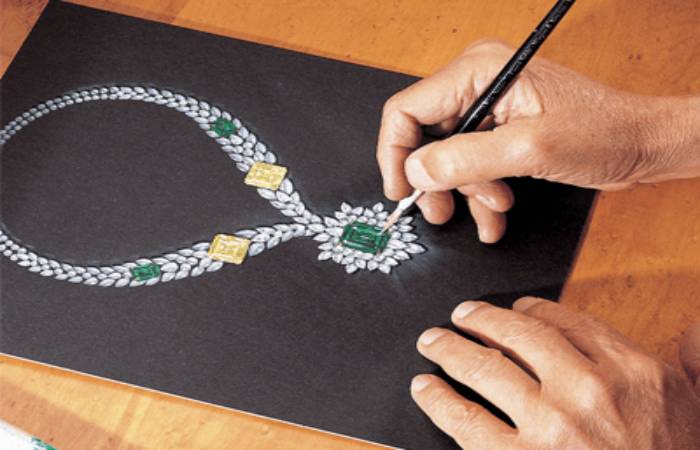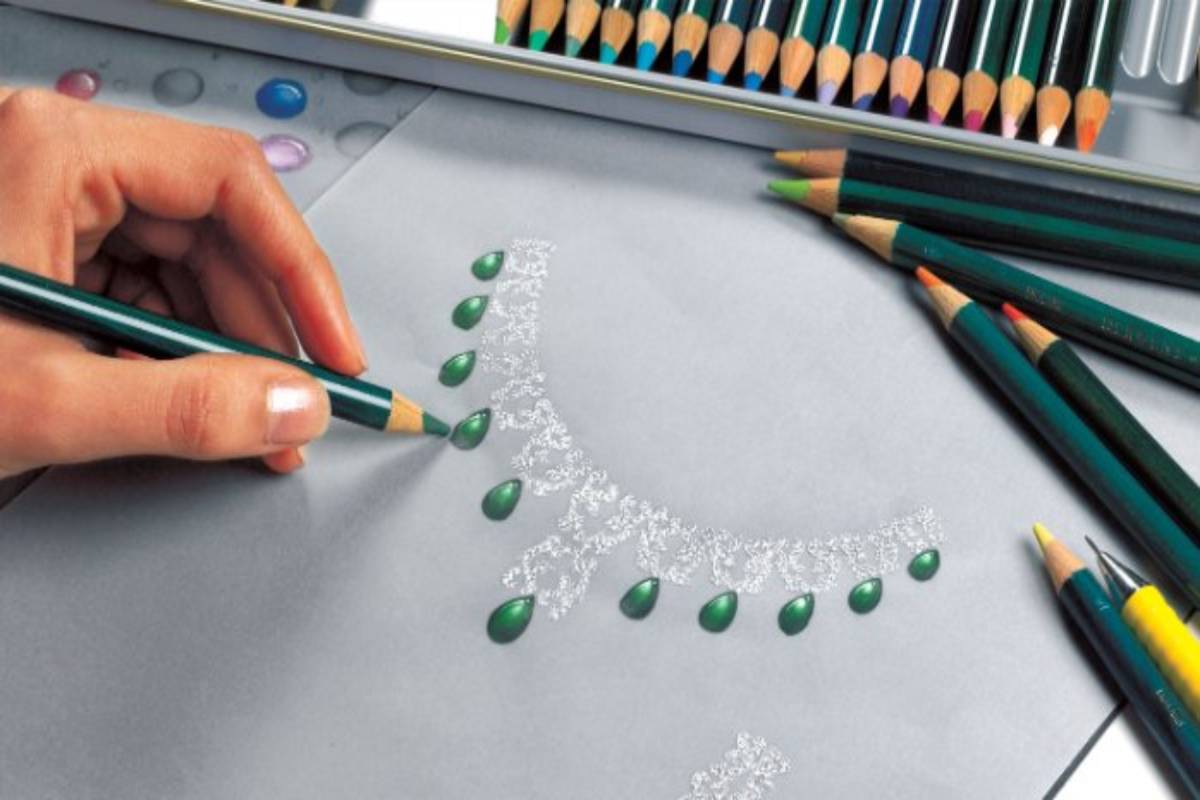Table of Contents
Jewellery Designer Definition
The jewellery designer is the trade or profession of creating, making, manufacture and draw jewellery. It is an ancient practice, formerly carried out by the goldsmith and metallurgist and which evolved into an activity that generated millions of dollars during industrialization. The course of design develop on a scientific, technical, and industrial basis, so the definition of jewellery crafts exclude.
Before accessory manufacture, it is projected and developed by a jewellery designer who has the knowledge and is qualified, not only in technology and the form-function relationship but also in composition, combination, accessory lines, clothing and Fashion.
Once the accessory defines, layout and represented, the prototype is made or directly manufactured with the necessary materials. The manufacturing process can be manual, as the designer generally prepare to do it himself, or with mass-produced machinery and tools, or a combination of both.
History of Jewellery Designer
The earliest signs of jewellery making were in ancient Egypt 3,000-5,000 years ago. Egyptians preferred the scarcity and workability of gold over other metals. In the predynastic period, jewellery began to symbolize religious status and power in the community.
How to become a Jewellery Designer?

Becoming a jewellery designer gives you the freedom to express yourself creatively and share your designs with the world to enjoy. You have the opportunity to be self-employed or work for reputable jewellers across the globe.
It is your choice to learn the trade through on-the-job training or gain formal training at a school. This job is perfect for driven people who need to share their creativity and style with others.
Method 1: Getting Started
1. Pick your Path to Become a Jewelry Designer
- There are many different routes you can take to becoming a professional and skilled jewellery designer. You can help pick your path by deciding what you may want to specialize in. Decide if you’re going to only design or design and create your jewellery.
- If you want to stick with just the design aspect, you may consider focusing on your illustration skills and getting an education in fashion and jewellery design.
- If you want to create your designs, you will have to gain practice, knowledge, and expertise in working with medals, jewels, and various raw materials to make jewellery. Try attending a reputable trade school for jewellers.
- Many jewellery designers skip school and learn through apprenticeships and on-the-job training by applying for work at reputable jewellers.
2. Learn the Basics
- New jewellery designers usually start by learning how to adjust, re-shape, and resize jewellery. From there, you can learn more difficult elements such as cutting and setting stones, mould-making, metalworking and engraving.
- Once you have these basic skills learned, you can focus on your style in shape and texture that you can practice mastering.
- Jewellers suggest learning about gemology, sales and jewellery fabrication to understand the process of jewellery production from beginning to end.
- While you do not need formal education, there are specific skills you may want to consider taking classes on.
- You will need manual dexterity, artistic gifts, steady hands, experience with CAD software to design, the ability to visual design ideas to actual jewellery, and a knowledge of popular fashion.
3. Give yourself a Competitive Edge with a Degree
- Depending on the specific route you take, you may benefit from going to school. Jewellery makers who become specialized or independent tend to be more successful with formal education.
- Also, employers find jewellers with a degree more appealing because they do not require as much on-the-job training as a person without proper instruction.
- This will help you stand out against the competition. You can take your education as far as a Bachelor of Arts, Bachelor of Fine Arts or Masters of Fine Arts in Metalwork and Jewelry Design.
- Many accredited universities and art institutes can allow you to cut and shape gems and pieces of metal first-hand.
- A few of the best jewellery design schools are Rochester Institute of Technology in New York, Istituto Lorenzo De Medici – The LdM School of Design in Italy, and Birmingham City University in England.
- Advanced credentials and experience can help you one day if you decide to start your own business.
4. Plan a Timeline
- Once you decide that you want to become a jewellery designer, you can begin practising right away by signing and creating your ideas.
- However, if you are looking at finding a job, it may be helpful to know how many years you will have to put in before that may happen.
- If you decide to receive a formal education, you can be in school anywhere from two to six years.
- You will need about one to two years of experience and on-the-job training to become a skilled designer. Keep in mind. You can receive this experience while you are still in school.
5. Learn the Process of Creation
When a jewellery designer has an idea for a piece of jewellery or present with a statement from someone else, several steps need to happen before that jewellery comes to life.
Depending on the situation, the design phase usually takes about seven days, and the production can take about two weeks. Here is the typical process of design to final product:
- The designer will start by drawing their ideas on paper with pencils. It has become common to design jewellery with special computer software to understand better what the piece will look like in 3D.
- The next step is to make a 2D design into a 3D prototype. This can do in various ways, such as 3D printing, CAD, or clay or wax moulds filled with melted metal.
- Once the prototype works out, the jeweller can start casting the metal.
- A jeweller can then cut, polish, and set precious or semi-precious gemstones into the jewellery.
Method 2: Practicing On Your Own
1. Gain Experience by Crafting at Home
You do not have to limit yourself to designing at a job or school. With the proper tools and materials, you can practice making your designs come to life. Materials and tools can become expensive, so you may want to start with just the basic materials. Here are some general means to get you started:
- Scissors that are professional-quality are great for cutting into different small places with ultra-sharp precision.
- Thread Clippers are helpful for quick snipping work.
- A standard graphing ruler is an essential piece of jewellery equipment that will help you visualize and create your designs.
- Use less expensive materials than what you imagine your design ultimately having. If you envision a piece with silver or gold fill, practise with copper wire or other base metal wire to get the hang of things.
- Hammers and mallets can be vital for forming jewellery.
2. Expand your Tool Collection
There are so many different types of tools required to make the wide range of jewellery available. The type of equipment you buy will become more specific once you decide what kind of jewellery you want to create. Here is a list of the standard equipment used to make jewellery that you may or may not need:
- Bead boards
- Disks and templates
- Anvils and blocks
- Wire jigs
- Stamps and punches
3. Invest in a Variety of Pliers
Pliers may be one of the most helpful tools you use to help you create your designs. They are many different pliers out there, and they all offer a unique way to help you make jewellery. Here are essential pliers to have in your tool kit:
- Wire cutters are great for cutting headpins, eye pins and wire to string jewellery.
- Round nose pliers are good when you want a smooth curve and help you make loops, bends, clasps and jump rings for wirework.
- Chain nose pliers have a flat surface and taper towards the tips, making them great for getting into small spaces and gripping wire. They are also helpful for opening and closing jump rings.
- Crimping pliers are a perfect tool for stringing beads because they have two notches on the jaws that easily secure tubes and beads.
Method 3: Growing in the Industry
1. Begin Work in the Industry
- It is vital to get your hands working as soon as possible to gain knowledge, practice, and skills. Apply at local jewellers to see if you can get your foot in the door in any way possible.
- Even working in the front of the store as a cashier can teach you a lot. You can learn how jewellery is displayed and presented to the customer and listen to their feedback about the pieces.
- Be sure that any jewellers you work with know the direction you head so that as positions open or help is needed designing or creating jewellery, you can consider for the job.
2. Network with as many People
- Spending time in an art, craft, or jewellery setting and putting the word out there, you have a passion for design.
- This is a great way to start a meaningful relationship with designers and other people who can help you launch your career in jewellery design.
- Bring value to that relationship by letting people know what skills you can provide, such as reliability, quality, sincerity, creativity, business and marketing knowledge, or dedication.
- Sell yourself and your skills, so other people in the industry want to have a connection with you.
3. Learn Good Communication Skills
- Jewellers work closely with employees and customers to figure out designs and talk jewellery. You will have to communicate with your customer about what they are looking for in their piece.
- This will require you to have excellent interpersonal skills to build strong relationships to help you sell jewellery successfully.
- Consider taking a communications class at a local college.
- Remember always to be polite and friendly when talking to fellow employees and customers.
4. Submerge yourself in the Fashion Culture
- Jewellery designers need to know the latest fashions in jewellery and jewellery history to stay current and sell jewellery. This will require research, attention to detail, and input from other people.
- Regardless of the education, you receive or the skills you learn, you will not be a competitive designer unless you have creative ideas that appeal to other people.
- Try to get internships with designers or volunteer at fashion events to learn about great styles.
- Read as many books as you can about the history of jewellery. Great books to start with are, History Of Jewellery by Black and Georgian Jewellery 1714-1830 by Ginny Redington.
Conclusion
The jewellery designer is the art or profession of designing and creating jewellery. Art has taken many forms throughout the centuries, from the simple beadwork of ancient times to the sophisticated metalworking and gem cutting is known in the modern-day.

